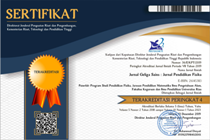Study of The Variation of Activating Agents on Specific Capacitance Values on The Synthesis of Supercapacitor Electrodes Based on Pepper Peel Waste
Abstract
The by-product of pepper production in Bangka Belitung is the waste of pepper skin. This waste tends to be untapped and thrown away so that it can disrupt the environmental ecosystem. One of the efforts to utilize pepper skin waste is processing it into activated carbon as the base material for supercapacitor electrodes. The initial stage of the synthesis was carried out by a pre-carbonization process on a sample of dry and clean pepper peel waste. Furthermore, the sample is chemically activated using a chemical activator and also physical activation at a temperature of 700ºC in N2 gas flow conditions. The activated carbon resulting from the activation is then molded into electrode plates in the form of pellets with a diameter of 1 cm. The electrode plates were characterized using a scanning electron microscope-energy dispersive x-ray (SEM-EDX) to determine morphology and cyclic voltammetry (CV) to determine the specific capacitance value. SEM test results show that the electrode sample has porous morphology and CV results show that the sample activated using the KOH activator has a specific capacitance value of 15.20 F/g. These results indicate that the activated carbon synthesized from the waste of pepper peel can be used as a supercapacitor electrode material and also a solution for overcoming the negative effects of pepper skin waste.
Full Text:
PDFReferences
Arie, A. A., Kristianto, H., Halim, M., & Lee, J. K. (2016). Synthesis and modification of activated carbon originated from Indonesian local Orange peel for lithium ion Capacitor’s cathode. Journal of Solid State Electrochemistry. https://doi.org/10.1007/s10008-016-3445-7.
Arif, E. N., Taer, E., & Farma, R. (2015). Pembuatan dan karakterisasi sel superkapasitor menggunakan karbon aktif monolit dari kayu karet berdasarkan variasi konsentrasi HNO3. JOM FiMIPA, 2(1), 49–55.
Fang, L. I., Junjun, S. H. I., & Xue, Q. I. N. (2010). Synthesis and supercapacitor characteristics of PANI/CNTs composites. 55(11), 1100–1106. https://doi.org/10.1007/s11434-009-0573-9.
Farma, R., Vivi, M., Sugiyanto, S., Awitdrus, A., Taer, E., & Yanuar, H. (2018). Cyclic Voltammetry Sel Superkapasitor Dengan Variasi Konsentrasi Aktivator Kalium Hidroksida. Jurnal Fisika Indonesia, 21(2), 20. https://doi.org/10.22146/jfi.42203.
Febriyanto, P., Jerry, J., Satria, A. W., & Devianto, H. (2019). Pembuatan Dan Karakterisasi Karbon Aktif Berbahan Baku Limbah Kulit Durian Sebagai Elektroda Superkapasitor. Jurnal Integrasi Proses, 8(1), 19. https://doi.org/10.36055/jip.v8i1.5439.
Hao, L., Li, X., & Zhi, L. (2013). Carbonaceous electrode materials for supercapacitors. Advanced Materials, 25(28), 3899–3904. https://doi.org/10.1002/adma.201301204.
Kurniawan, P., Taer, E., Malik, U., & Taslim, R. (2018). Pengaruh konsentrasi KOH terhadap sifat fisis dan elektrokimia elektroda karbon dari limbah kulit durian sebagai sel superkonduktor. Jurnal Komunikasi Fisika Indonesia, 15(01), 85–92.
Kurniawan, W. B., Indriawati, A., Marina, D., & Taer, E. (2019). The Potential of Pepper Shell ( Piper Nigrum ) for Supercapacitor Electrodes. Jurnal Pendidikan Fisika Indonesia Al-Biruni, 08(April), 109–116. https://doi.org/10.24042/jipfalbiruni.v8i1.3780.
Kurniawan, W., Indriawati, A., & Marina, D. (2019). The Effect of Particle Size on the Performance of Electrode Supercapacitor based on Pepper (Pipper Nigrum) Shell Activated Carbon. IOP Conference Series: Earth and Environmental Science, 353(1). https://doi.org/10.1088/1755-1315/353/1/012041.
Rosalina, Suprihatin, & Karo, P. K. (2017). Pengaruh Luas Permukaan Spesifik terhadap Kapasitansi Spesifik Elektrode Zeolit Akibat Variasi Suhu Kalsinasi. Jurnal Teori Dan Aplikasi Fisika, 5(1), 37–42.
Syarif, N., & Pardede, M. C. (2014). Hydrothermal Assisted Microwave Pyrolysis of Water Hyacinth for Electrochemical Capacitors Electrodes. International Transaction Journal of Engineering, Management, & Applied Sciences & Technologies, 5(2), 95–104.
Tetra, O. N., Aziz, H., Ibrahim, S., Alif, A., Kimia, J., Matematika, F., Ilmu, D., Alam, P., & Andalas, U. (2018). Review : Superkapasitor berbahan dasar karbon aktif dan larutan ionik sebagai elektrolit. Riview: Superkapasitor based on activited carbon and ionic solution as electrolyte. 6(1), 39–46.
Tumimomor, F., Maddu, A., & Pari, G. (2017). Pemanfaatan Karbon Aktif Dari Bambu Sebagai Elektroda Superkapasitor. Jurnal Ilmiah Sains, 17(1), 73. https://doi.org/10.35799/jis.17.1.2017.15802.
Xiao, Z., Chen, W., Liu, K., Cui, P., & Zhan, D. (2018). Porous Biomass Carbon Derived from Peanut Shells as Electrode Materials with Enhanced Electrochemical Performance for Supercapacitors. 13, 5370–5381. https://doi.org/10.20964/2018.06.54.
Zulkifli, Awitdrus, & Taer, E. (2018). Studi Awal Pemanfaatan Purun Tikus Sebagai Elektroda Superkapasitor Menggunakan Aktivasi Uap Air The Preliminary Study of Utilization of Water Chestnut as Supercapacitor Electrode Using Steam Activation. J.Aceh Phys.Soc, 7(1), 30–34.
DOI: http://dx.doi.org/10.31258/jgs.9.1.19-25
Refbacks
- There are currently no refbacks.
Copyright (c) 2021 Widodo Budi Kurniawan, Anisa Indriawati, Siska Oktaviani

This work is licensed under a Creative Commons Attribution 4.0 International License.
Jurnal ini terdaftar dan terindeks pada:
- Crossref
- Google Scholar
- Crossref
- Garuda
- Sinta
- Researchgate
- Dimensions
- Base
- Scilit
- OneSearch
- Road
- CiteFactor
- ResearchBib
- WorldCat



















